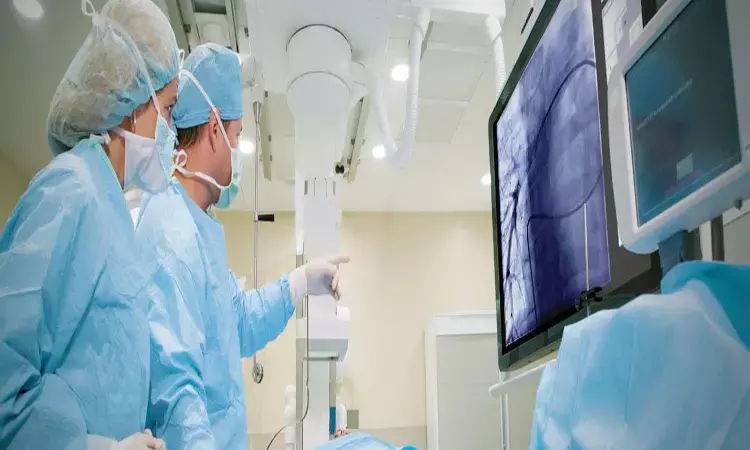- Home
- Medical news & Guidelines
- Anesthesiology
- Cardiology and CTVS
- Critical Care
- Dentistry
- Dermatology
- Diabetes and Endocrinology
- ENT
- Gastroenterology
- Medicine
- Nephrology
- Neurology
- Obstretics-Gynaecology
- Oncology
- Ophthalmology
- Orthopaedics
- Pediatrics-Neonatology
- Psychiatry
- Pulmonology
- Radiology
- Surgery
- Urology
- Laboratory Medicine
- Diet
- Nursing
- Paramedical
- Physiotherapy
- Health news
- Fact Check
- Bone Health Fact Check
- Brain Health Fact Check
- Cancer Related Fact Check
- Child Care Fact Check
- Dental and oral health fact check
- Diabetes and metabolic health fact check
- Diet and Nutrition Fact Check
- Eye and ENT Care Fact Check
- Fitness fact check
- Gut health fact check
- Heart health fact check
- Kidney health fact check
- Medical education fact check
- Men's health fact check
- Respiratory fact check
- Skin and hair care fact check
- Vaccine and Immunization fact check
- Women's health fact check
- AYUSH
- State News
- Andaman and Nicobar Islands
- Andhra Pradesh
- Arunachal Pradesh
- Assam
- Bihar
- Chandigarh
- Chattisgarh
- Dadra and Nagar Haveli
- Daman and Diu
- Delhi
- Goa
- Gujarat
- Haryana
- Himachal Pradesh
- Jammu & Kashmir
- Jharkhand
- Karnataka
- Kerala
- Ladakh
- Lakshadweep
- Madhya Pradesh
- Maharashtra
- Manipur
- Meghalaya
- Mizoram
- Nagaland
- Odisha
- Puducherry
- Punjab
- Rajasthan
- Sikkim
- Tamil Nadu
- Telangana
- Tripura
- Uttar Pradesh
- Uttrakhand
- West Bengal
- Medical Education
- Industry
Direct admission to cath lab for primary PCI lowers death risk in STEMI patients: JAHA

Israel: Direct admission of PPCI-treated patients with STEMI to the cath lab decreases mortality by shortening D2B and P2B intervals, suggests a recent study in the Journal of the American Heart Association. Thus, all efforts should be extended to shorten pain‐to‐balloon (P2B) interval in such patients.
In simpler words these findings support efforts to increase the proportion of STEMI patients requiring primary PCI who are directly admitted instead of being admitted via the emergency department. The researchers stress on the significance of educating the public, emergency medical crews, and staff about the importance of lowering the P2B interval.
Shortening the pain‐to‐balloon (P2B) and door‐to‐balloon (D2B) intervals is essential in patients with ST‐segment–elevation myocardial infarction (STEMI) treated by primary percutaneous coronary intervention (PPCI) in order to limit myocardial damage. Simcha R. Meisel, Technion‐Israel Institute of Technology, Haifa, Israel, and colleagues investigated whether direct admission of PPCI‐treated patients with STEMI to the catheterization laboratory, bypassing the emergency department, expedites reperfusion and improves prognosis.
Consecutive PPCI‐treated patients with STEMI included in the ACSIS (Acute Coronary Syndrome in Israel Survey), a prospective nationwide multicenter registry, were divided into patients admitted directly or via the emergency department. The impact of the P2B and D2B intervals on mortality was compared between groups. Of the 4839 PPCI‐treated patients with STEMI, 1174 were admitted directly and 3665 via the emergency department.
Key findings of the study include:
- Respective median P2B and D2B were shorter among the directly admitted patients with STEMI (160 and 35 minutes) compared with those admitted via the emergency department (210 and 75 minutes).
- Decreased mortality was observed with direct admission at 1 and 2 years and at the end of follow‐up (median 6.4 years).
- Survival advantage persisted after adjustment by logistic regression and propensity matching. P2B, but not D2B, impacted survival.
"Direct admission decreases mortality in PPCI‐treated patients with STEMI by shortening P2B and D2B intervals considerably. P2B, but not D2B, impacted mortality," wrote the authors. "Thus, all efforts should be extended to shorten P2B by educating the public to activate early the emergency medical services to bypass the emergency department and allow timely PPCI for the best outcome."
The study titled, "Direct Admission of Patients With ST‐Segment–Elevation Myocardial Infarction to the Catheterization Laboratory Shortens Pain‐to‐Balloon and Door‐to‐Balloon Time Intervals but Only the Pain‐to‐Balloon Interval Impacts Short‐ and Long‐Term Mortality," is published in the Journal of the American Heart Association.
DOI: https://www.ahajournals.org/doi/10.1161/JAHA.120.018343
Dr Kamal Kant Kohli-MBBS, DTCD- a chest specialist with more than 30 years of practice and a flair for writing clinical articles, Dr Kamal Kant Kohli joined Medical Dialogues as a Chief Editor of Medical News. Besides writing articles, as an editor, he proofreads and verifies all the medical content published on Medical Dialogues including those coming from journals, studies,medical conferences,guidelines etc. Email: drkohli@medicaldialogues.in. Contact no. 011-43720751


